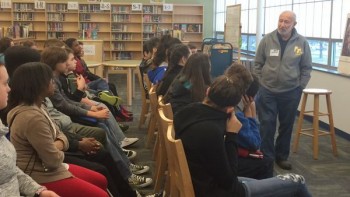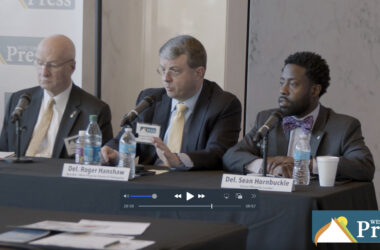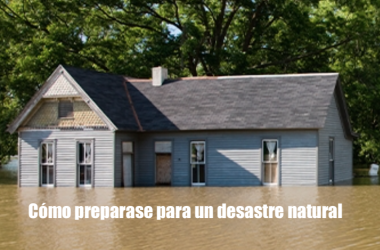
Mark Strauss, a holocaust survivor and artist, speaks to eighth-graders at North Middle School on Tuesday morning.
MARTINSBURG, W.Va. — In the library at Martinsburg North Middle School on Tuesday morning, Mark Strauss, a Poland-native and Holocaust survivor, spoke to eighth-graders.
Lurah Cochran, eighth-grade English language arts teacher, said the students have been learning about the Holocaust in their classes.
Cochran said the students have been reading works by Anne Frank and her class has an entire unit on the Holocaust. The class will travel to the United States Holocaust Memorial Museum in Washington, D.C., on Feb. 29.
Jennifer Geary, a mother of a North Middle eighth-grader, first met Strauss two years ago when she went to his art gallery in Virginia. After hearing her son talk about his upcoming class trip to the museum, Geary wanted to arrange an opportunity for the students to hear Strauss’s story.
“I’ve been to the Holocaust Museum and I am not Jewish, but it was still emotional. If I were to go now after meeting him, it would be a totally different experience. So I wanted the kids to have that and for the kids to have a genuine appreciation for what they were going to see,” Geary said.
Strauss told the students his story, his struggles and how he’s tried to overcome them.
Strauss was 11 when the Nazi army invaded his town of Lvov (L’viv) in southeastern Poland in 1941. Strauss said he was taken by the soldiers’ morale. He recalled how happy they looked and acted but he had no idea what was going to occur next.
Before any concentration camps existed, almost 85,000 Jewish people were killed within the first year of the war, out of the approximately 100,000 that lived in his town, Strauss said.
Strauss and his parents were forced to live in a ghetto. He explained how minorities and those whom the Nazis hated were starved, overworked, beaten, shot and gassed to death.
Strauss described the horrendous conditions, conditions he said are just unimaginable for a normal person to conceive.
Luckily, he was able to escape the ghetto. Strauss’s father worked as a part of forced labor entered and existed the ghetto in a military style formations. After about three months, on a cold and dreary day, Strauss saw his opportunity.
“It wasn’t nice outside and the guards didn’t want to be out there either. Usually they checked for the badges of people to make sure they were allowed to go in and out, but for whatever reason on that day they weren’t really. I hid in the middle of everyone and walked right out amongst them,” Strauss said.
Strauss said the plan was pre-arranged and that his “angel,” a Polish-Catholic woman brought him to her home in Poland where he hid for over a year and a half. He stayed in her attic until he was 14.
Strauss described how he was unable to leave, was nearly starving to death because there was no food, just living in a 10-by 7-foot room.
He said how his parents fortunately escaped as well. Strauss said his parents knew the “end was near” and that everyone in the ghetto was to die the next day. They had to get out.
His mother and father both escaped, spending the night in a tomb in a cemetery before his mother was able to travel to a house where she was taken in.
His father was unable to go with her, forcing him back to the ghetto to give himself up freely. By that time the Nazi troops had already killed and torched the houses in the village.
Strauss’s father was spared from dying, but was forced to burn the corpses, even grinding their bones into dust with a machine the Nazis provided.
In 1944, the Soviets liberated Strauss and his parents.
Strauss said although he was free to leave the house he had hidden in for so long, he couldn’t even stand on his own two feet.
“I was just a bag of bones. I didn’t have the power to stand, just a bag of bones,” Strauss said. “When it was time to leave, my father had to carry me out.”
From starvation and lack of physical activity, it took him four months to regain his strength to walk. Strauss said after a while he was able to walk with crutches, then was able to walk short distances and eventually, was able to walk again.
In January 1947, at the age of 17, Strauss and his parents emigrated to the United States. They first arrived in New York and then established themselves in Newark, N.J.
After coming to the U.S., Strauss received a doctorate in Chemistry from Cincinnati University, later becoming a nuclear scientist and working at the Massachusetts Institute of Technology.
Strauss also had the desire to join the military because he said he never wanted to feel like he couldn’t defend himself or his family ever again. So. he joined the Navy when he was 30, where he worked on nuclear submarines.
Strauss ended up in Virginia after he, his wife and their family bought a farm. He said painting was never something he was interested in, but it developed after buying his wife a watercolor kit that she never used.
Over the years, Strauss’s love for art grew and grew, and ultimately he knew he wanted to do it full-time. Strauss said he draws inspiration through everything in his life, even his gruesome past.
Strauss said he is not angry for what happened to him and his family and he is thankful to be alive.
In closing, Strauss told the students, “don’t waste your time on dislike or hate.” He said no matter someone’s religion or color of their skin, as long as they are a good person, that is what should matter.
In addition to being a painter, Strauss has published five books and is currently working on his sixth. His work can be seen in the United States Holocaust Memorial Museum, the National Air and Space Museum and The Edinburg Gallery in Edinburg, Virginia.
For more information visit, markstrauss.com.
-Staff writer Katiann Marshall can be reached at 304-263-8931, ext. 182, or at Twitter.com/KmarshallJN.






